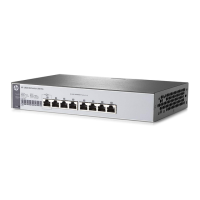Partner Port State
State information of the peer port:
• A—Indicates that LACP is enabled.
• B—Indicates that LACP short timeout has occurred. If B does not appear, it
—Indicates that LACP long timeout has occurred.
• C—Indicates that the link is considered aggregatable by the sending
system.
• D—Indicates that the link is considered as synchronized by the sending
system.
• E—Indicates that the sending system considers that collection of incoming
frames is enabled on the link.
• F—Indicates that the sending system considers that distribution of outgoing
frames is enabled on the link.
• G—Indicates that the receive state machine of the sending system is using
the default operational partner information.
• H—Indicates that the receive state machine of the sending system is in
expired state.
Oper Key Operational key of the local port.
Table 65 Field description
Field Descri
Unit Number of the remote system.
Port Name of the remote port.
Partner ID LACP priority and MAC address of the remote system.
Partner Port Priority LACP priority of the remote port.
Partner Oper Key Operational key of the remote port.
Link aggregation and LACP configuration example
Network requirements
As shown in Figure 175, aggregate the ports on each device to form a link aggregation group, balancing
incoming/outgoing traffic across the member ports.
Figure 175 Network diagram

